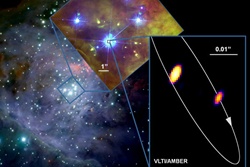
The new image of the double star, Theta 1 Orionis C, was taken with the European Southern Observatory's Very Large Telescope Interferometer (VLTI), astronomers from the Max-Planck-Institute for Radio Astronomy in Bonn, Germany, reported in the journal Astronomy and Astrophysics on Thursday.
Theta 1 Orionis C represents the brightest and most massive star in Orion Trapezium Cluster, the nearest high-mass stars-forming region to Earth, and scientists describe it as a unique laboratory for studying the formation process of massive stars in detail.
The intense radiation of Theta 1 Ori C, they said, is ionizing the whole Orion nebula, and its strong wind shapes the famous Orion proplyds, young stars that are still surrounded by their protoplanetary dust disks.
Since Theta 1 Ori C is such a bright star, astronomers did not detected the existence of a close companion under 1999.
Now, a near-infrared beam-combination instrument known as AMBER installed at the VLTI "allowed us, for the first time, to obtain an image of this system with the spectacular angular resolution of only two milli-arcseconds," said Stefan Kraus, the study's author.
"This corresponds to the resolving power of a space telescope with a mirror diameter of 130 meters," he added.
The AMBER new image "clearly separates the two young, massive stars of this system," said a press release from the Max-Planck-Institute for Radio Astronomy.
Combining AMBER observations with position measurements of the system over the past 12 years, the astronomers were able to calculate that the pair is on a very eccentric orbit with a period of 11 years.
The masses of the two stars, they said, were derived to be 38 and 9 solar masses. Furthermore, they estimated the system was located at about 1350 light years from Earth.
"These results are important for studies of the Orion region as well as the improvement of theoretical models of high-mass star formation," the release noted.



Reader Comments
to our Newsletter